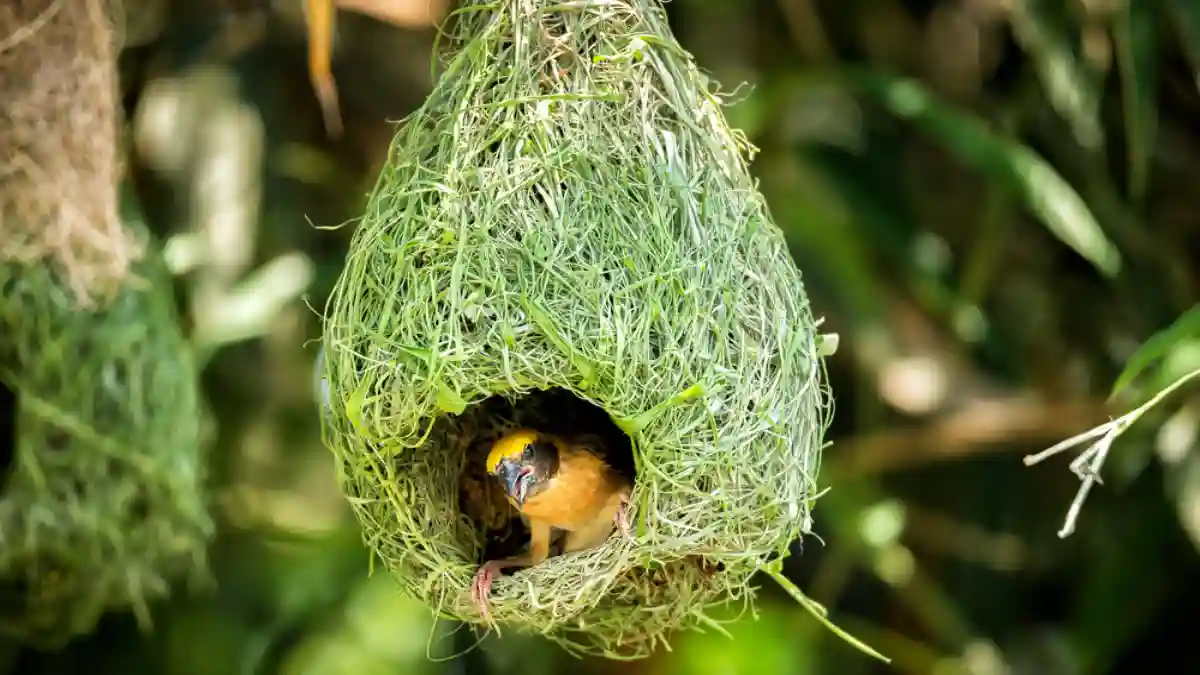My favorite birds’ nests are the hanging ones, incredible feats of achievement that stay attached to branches of trees swaying in the breeze. I’ve often wondered which birds make these nests, so I decided to do a little research on the topic and found ten birds that make hanging nests.
So what are the birds that make hanging nests?
Certain birds prefer to build hanging nests than build nests in trees. These birds include:
- Baltimore Oriole
- American Bushtit
- Montezuma Oropendola
- Warbling Viveo
- Golden-Crowned Kinglet
- Baya Weaver
- Purple-Rumped Sunbird
- Common Firecrest
- Warbling White-Eye
- Goldcrest
Not all hanging nests are the same; they are different sizes and shapes and are located in different environments worldwide.
Now that we know the names of ten birds that make hanging nests let’s look at each of these birds and the kinds of hanging nests they build. (Know what to feed a baby bird)
Common Birds That Make Hanging Nests
You will find multiple different bird species making their nests during the breeding season all over the World. Many create beautiful hanging nests during this time; the following birds are a few hanging nest builders.
Baltimore Oriole
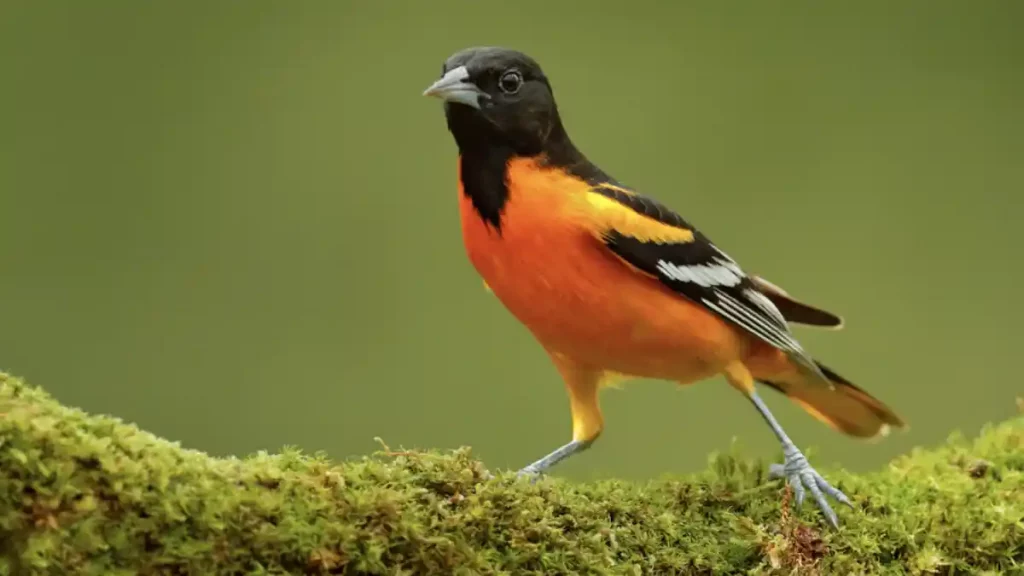
The Baltimore Oriole’s nesting grounds are in east-central and eastern North America. These birds prefer open forest edges, woodlands, small groves of trees, and river banks.
Having adapted well to human settlements, the Baltimore Orioles can be found feeding and nesting in orchards, parks, and backyards.
Baltimore Orioles build unique hanging nests that appear sock-like.
The nest, which the female weaves using thin fibers, is usually around 3 to 4 inches deep, with a 2 to 3 inches wide opening.
You can find this distinctive nest hanging below a branch, or sometimes, you can find them anchored to a vertical tree trunk.
American Bushtit

American Bushtits prefer to live in scrubby areas or open woodlands, but you can also find them in parks and suburbs.
They will live in sagebrush, scrub, streamside thickets and woods, and forests of juniper, pine, and other evergreens, ranging to 11,500 feet elevation.
They will make their nests on the branches or trunks of trees ranging in height from 3 to 100 feet. The male and the female are both involved in building the nest, resulting in an excellent hanging nest.
The nests typically hang up to a foot below their anchor point. The entrance hole can be found in the side, close to the top, leading down into the nest bowl.
Montezuma Oropendola
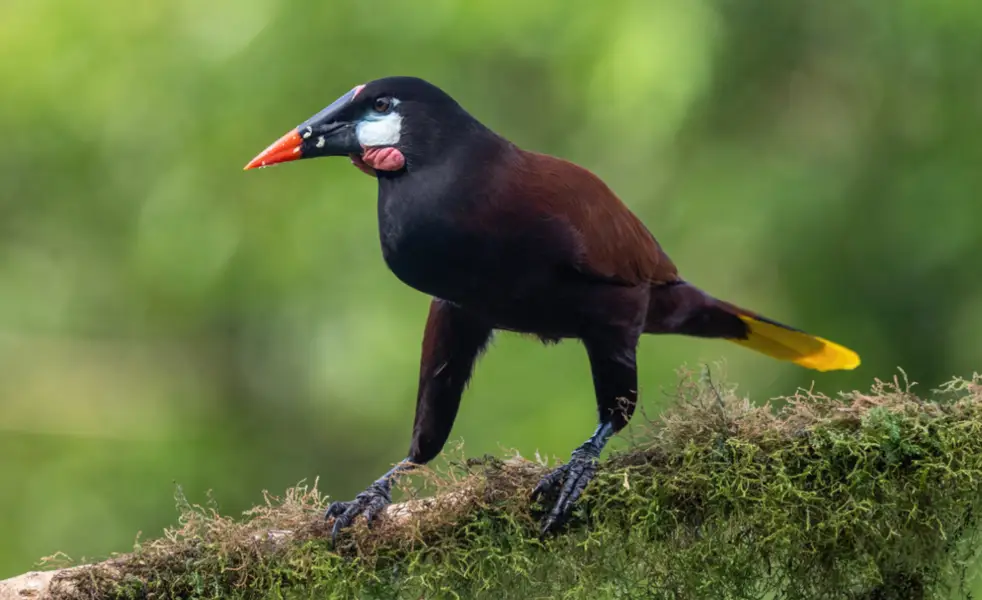
Montezuma Oropendola’s nesting grounds are in the Caribbean coastal lowlands, from central Panama to southeastern Mexico, but you won’t see them in southern Guatemala and El Salvador. They prefer to nest in forest edges, canopies, and old plantations.
Montezuma Oropendola’s breed in colonies and build their nests high up in trees. These hanging nests can be up to 23.6 – 39 inches long.
The number of nests in a colony is around 30. Although, some have many more, with the highest recorded nests in a territory being 172.
Warbling Vireo
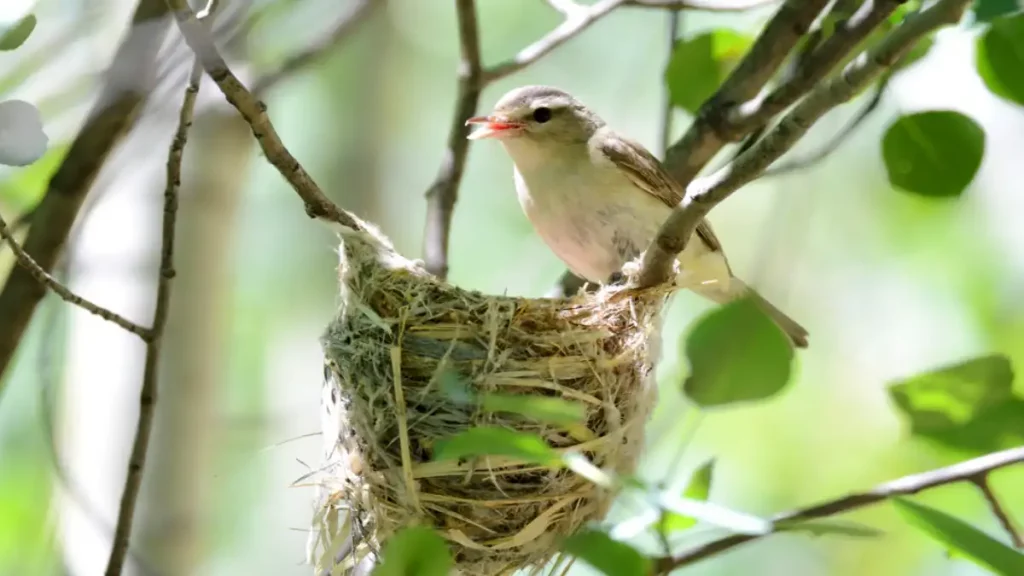
During the breeding season, you can find warbling Vireos in mature deciduous woodlands, ranging from sea level to 10,500 feet in elevation.
They prefer areas near ponds, streams, lakes, and marshes. You can also find them amongst humans in urban parks, campgrounds, neighborhoods, and orchards.
Their nests can be found 3 – 140 feet above the ground, in the outer portions of tall shrubs and deciduous trees.
Warbling Vireos usually suspend their nests from horizontally forked twigs, weaving a rough, hanging cup that is slightly rounded.
Females are the primary nest builders, and they construct a nest that is typically 2 – 3 inches deep and 3 inches across.
Golden-Crowned Kinglet

The breeding grounds of the Golden-crowned Kinglet are typically in montane or boreal coniferous forests ranging up to 11,000 feet elevation.
They will also nest in mixed and deciduous forests, conifer plantations, wooded bogs, groves in cemeteries and parks, and cottonwood-willow forests.
They like to place their nests high up from the ground, typically at about 60 feet.
Both male and female Golden-crowned Kinglets build the nest, making it deep and cup-shaped with four corners, either resting on twigs or suspended.
After its completion, the nest typically measures 3 inches across and 3 inches high.
Baya Weaver
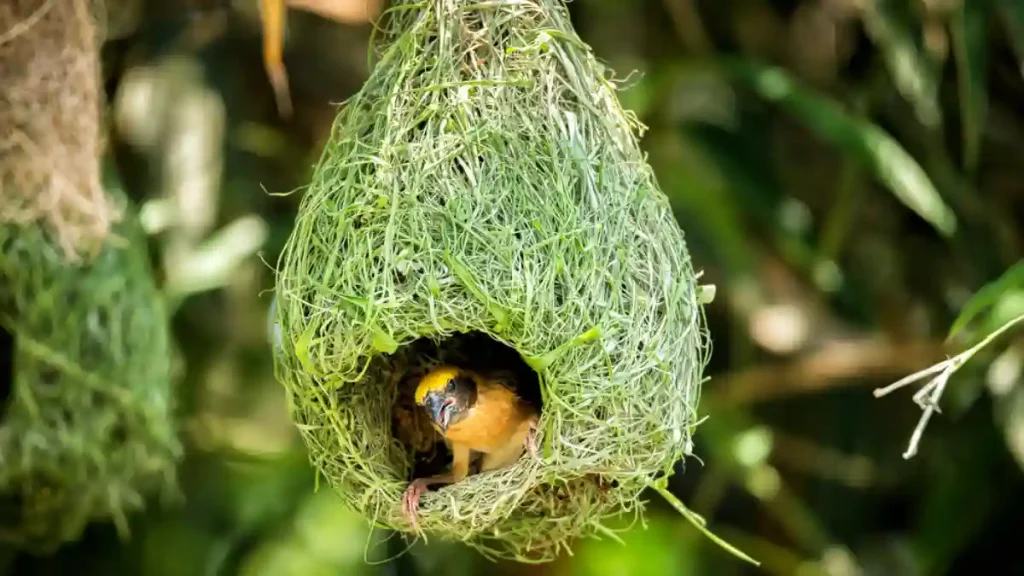
The Baya Weaver is found across Southeast and South Asia and likes to inhabit cultivated areas, grassland, secondary and shrub growths usually near brackish or freshwater.
Baya Weavers are social birds and build their nests in colonies. You might find 20 – 30 nests in one tree always positioned close to nesting material, food, and water.
Often the nests are built hanging over the water, and you will find them 6.5 feet to 98 feet above the ground or water. The male builds the nest to attract a female; he will only complete it if a female accepts it.
The pendulous nests are retort-shaped, typically with a long entrance tunnel of up to 15.7 – 25.6 inches in length, with a central nesting chamber.
An average nest is around 2.1 inches across and 2.1 inches deep.
Purple-Rumped Sunbird
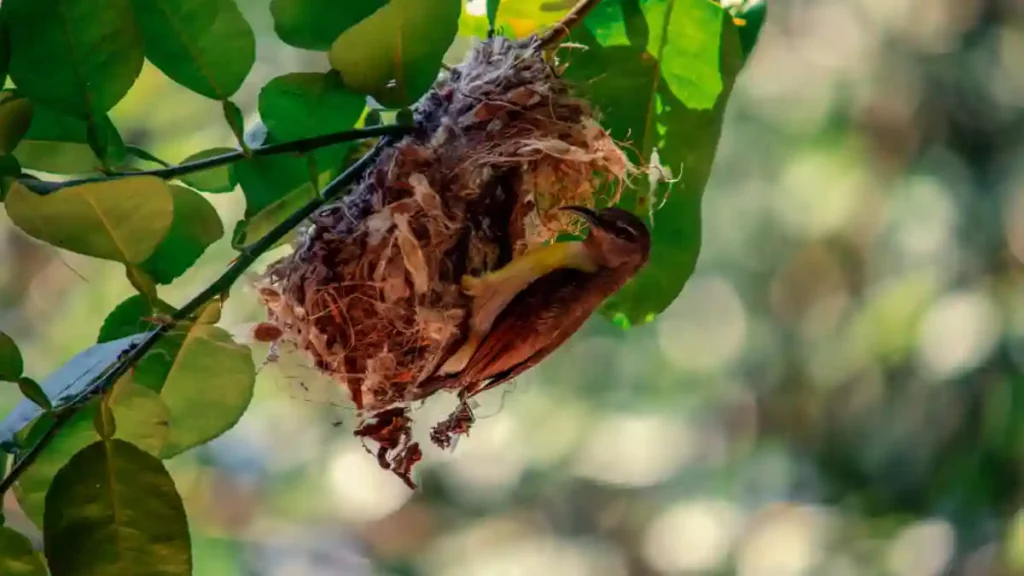
The Purple-rumped Sunbird, also known as the Small Sunbird, can be found in Sri Lanka, southern India, and Bangladesh.
Preferring to avoid dense forests, you can locate Purple-rumped Sunbirds in varying habitats, including scrubs, trees, and cultivated areas.
The female will build the nest independently, often placing it under open porches or next to a building. She will usually create the entrance to her nest facing a bush for safety.
Common Firecrest

The breeding grounds of the Common Firecrest are the temperate areas of northwestern Africa and Europe.
They prefer to build their hanging nests in coniferous or broadleaved woodlands and gardens, constructing nests on the branches of trees.
The female Common Firecrest is responsible for the construction of the nest.
Typically, the female will hang her nest from the tree’s lower branches, although records show that some nests have been suspended 8 – 65 feet above the ground.
The nests typically measure 3 inches across and 2 – 2.5 inches deep; the walls are around 0.8 inches thick.
Warbling White-Eye

The Warbling White-Eye is native to East Asia and found in Indonesia, Japan, the Philippines, South Korea, and Timor-Leste.
They prefer to occupy open woodlands, forests, shrubland, and thickets. You can also find them in gardens, city parks, groves, and plantations.
Male and female Warbling White-Eyes are monogamous, and the male will designate a territory in which they will create their nest.
Nests are typically placed 3.2 – 98.4 feet above ground level. The nests are generally cup-shaped, measuring 2.2 inches deep and 1.6 inches across.
Goldcrest
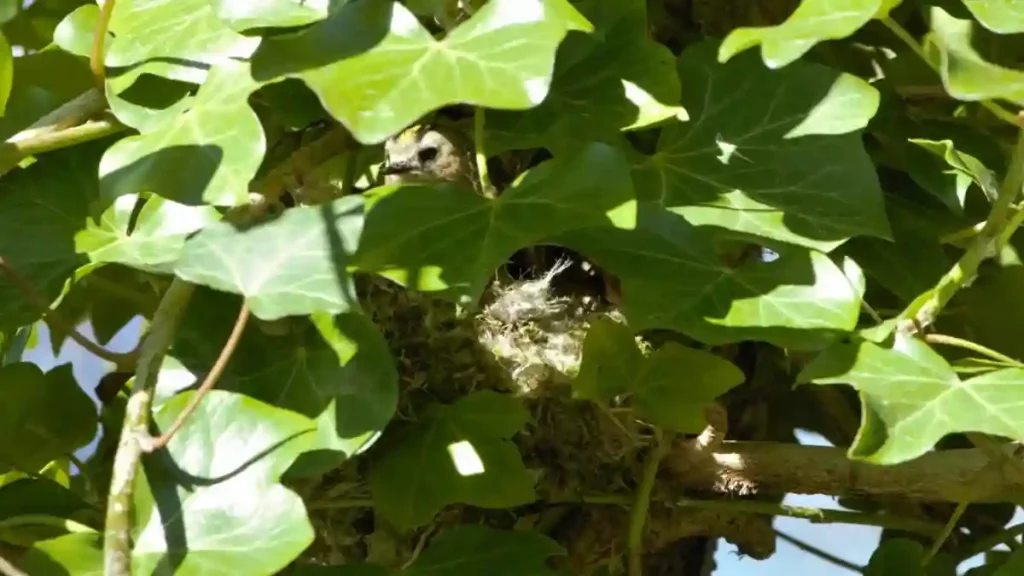
The Goldcrest resides across Europe, northern Africa, North Asia, northern Arabia, and Iceland.
They prefer to live in mixed woodland, coniferous woodland, the occasional garden, park, or cemetery as they offer a suitable conifer that isn’t otherwise locally available.
The male and female Goldcrest build the nest together, with the female doing the majority of the work. They build delicate nests typically suspended from twigs.
They can often be spotted buried among ivy or on conifer branches. The nests hang close to the ground, although reports vary from 3.3 – 72.2 feet off the ground.
They are usually cup-shaped and have an internal diameter of 3.5 inches.
Conclusion
Hanging nests are some of the most amazing kinds of birds nests you will see.
Coming in a variety of forms, nests can be cup-shaped to retort-shaped. You can find them close to the ground or 100 feet in the air. Males construct nests on their own or the female on her own, or both partners will build a nest together.


